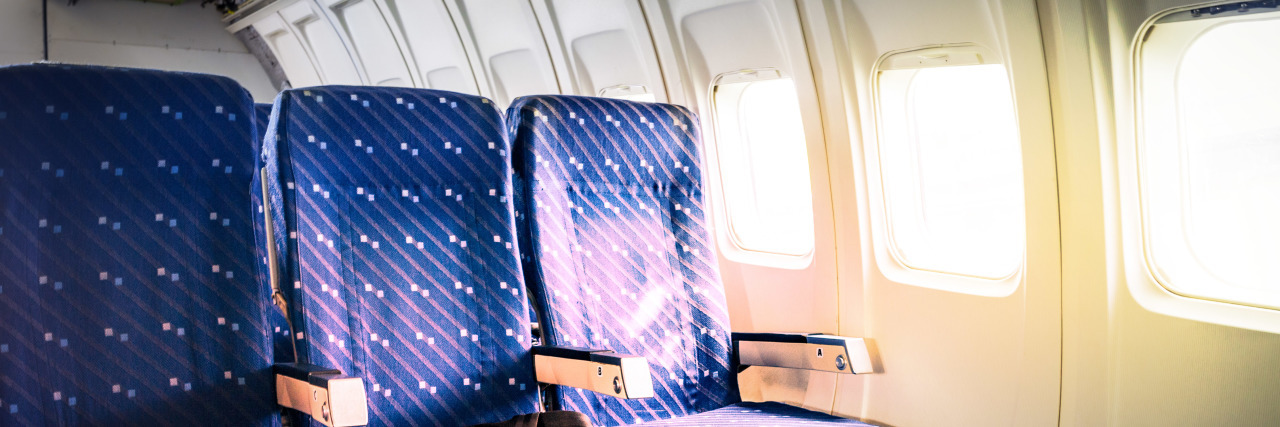In early 2009, I fell through a bridge while cycling in Cambodia, losing consciousness and landing on a rocky riverbank 30 feet below. My body was battered, my bones shattered and the injuries were many: Nerve and muscle damage, a leg shortened from impact. My lower back took the brunt of the fall, sustaining multiple ruptures from L5 down to my sacrum.
A few years ago, I nearly voiced the grim details of my injury to a British Airways flight attendant. Rushing down the aisle in her high heels, minutes before take-off, she took glanced at seated passengers and braked by my side. “Put your feet on the floor!” she growled, ostensibly alarmed by my seated position. I was properly buckled up, but my legs were folded underneath me and tucked onto a folded pillow. I understood the optics; I wasn’t sitting “normally.”
It wasn’t the first time I found myself on the receiving end of this expressed doubt (verging on verbal assault). Among the known sequelae presenting after a precipitous fall are impairments in the lower torso. Ever since my back and butt hit rock bottom, travel of any kind has become an unimaginably stressful endeavor. Not only because it requires that I expend more energy and stamina — all of it diminished, in spades, after the fall — but it also takes a heavy physical toll on my body. My mind shifts into high alert, riddled with forethought: Plan ahead, pack mindfully and lightly. Practice patience in the face of skepticism. In other words, don’t make waves.
Looking up at the harried attendant, I tried to explain — in my gentlest voice, bordering on apologetic — that I was unable to do so. “I can’t place my feet on the floor because I can’t sit… normally.” The heavyset woman, beads of sweat forming at her temples, glared at me as if unable to process my words. I produced a medical note; she reached for it and scurried off. When she returned, her gaze softened only slightly.
“OK, but you have to understand that this is an unusual request,” she said in muted tones. “I’ve never… uhhh… had to deal with this before.” I let the silence between us hang in the air, unsure of how to respond. Are you trying to make me feel bad or guilty? Do you think this is intentional? Can you imagine how your day might unfold if you could not sit? Instead I nodded, retrieved my letter, gazed out the window and returned to my breath.
Clearly, trying to explain the relative uniqueness of my circumstances to this woman would be far from straightforward. How could I explain that I can’t sit, that I can’t carry much weight; that I can’t stand in long lines? How would I make her understand that my disabilities – chronic pain and neuropathy included – are unseen? Invisible disabilities must be understood and believed.
To able-bodied people, sitting happens mindlessly; it is an ordinary part of daily life. To voice one’s inability to sit subverts our common understanding of normalcy. “But you look so normal,” people have said to me over the years. What do you mean, you can’t sit? Can you sit on the floor? How about this chair? But you can ride a bicycle, right? They look me over, searching perhaps for visual cues.
Dozens of physical, mental, intellectual and neurological conditions are unseen. So in traveling with an invisible inability (my preferred term) I feel abnormally burdened: I’m obliged to practice diplomacy, negotiate foreign terrain and propose modifications.
I first confronted these skeptics while waiting in the departures area of New York’s JFK Airport, on my way to Italy for a conference. “What do you mean, you can’t sit?” an inconvenienced airport employee barked at me. She was seething, a woman on the verge. Moments before, she’d arrived at our designated meeting point, navigating a wheelchair with one hand. I’d devised a strategy to request a wheelchair, believing it would provide a legitimate excuse for an attendant to help me bypass long security and customs queues. But with that wheelchair in tow, she expected me to sit down. There was no getting through to her. Feeling nervous and mildly panicked, I stood my ground.
Once in a while, I get lucky. Like the time that a porter at Amsterdam’s Schiphol airport approached me with a wheelchair and an open ear. After my brief explanation, he collapsed the chair without missing a beat, took my passport, swung my handbag over his shoulder and forged ahead, unchallenged, through all the lines — with me on his tail.
Elsewhere too, I find hints of progress. Recently, a friend sent me a link to a story about how British airport authorities (and the Sainsbury’s supermarket chain) had implemented initiatives addressing the “additional needs” of customers with hidden disabilities. A sunflower lanyard was “purposely designed to act as a discreet sign for store colleagues to recognize if they may need to provide a customer with additional support when in store.” Clients presenting with any number of invisible limitations would, theoretically at least, be offered a lanyard and handled with care.
I’m grateful for innovations that respond to the needs of a minority with sensitivity and concern. But there is still a long way to go. People can’t wrap their heads around what they cannot see. They don’t remember. I’m still offered a chair, a spot on a hardwood bench; and I’m always asked to sit “properly” on plane seats. I cringe every time at the prospect of more explanations, more notes, more disbelief. A decade on, the reminders continue. But now, change — and hope – are afoot.
Getty image by tsvibrav.

